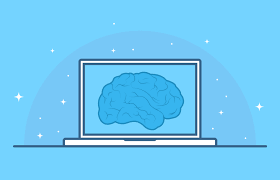
This month’s blog post is an introduction to Artificial Intelligence or AI for short. There has been a buzz in the news and online about AI – we’ll take a look at what is AI and the good and bad discussions that are out there about it.
What Is AI?
AI is a wide-ranging branch of computer science concerned with building smart machines capable of performing tasks that typically require human intelligence. While AI is an interdisciplinary science with multiple approaches, advancements in machine learning and deep learning, in particular, are creating a paradigm shift in virtually every sector of the tech industry.
Artificial intelligence allows machines to model, or even improve upon, the capabilities of the human mind. And from the development of self-driving cars to the proliferation of smart assistants like Siri and Alexa, AI is increasingly becoming part of everyday life.
Broadly speaking, artificially intelligent systems can perform tasks commonly associated with human cognitive functions — such as interpreting speech, playing games and identifying patterns. They typically learn how to do so by processing massive amounts of data, looking for patterns to model in their own decision-making. People in AI development categorize AI into two groups: strong and weak.
Strong AI, also known as artificial general intelligence, is a machine that can solve problems it’s never been trained to work on — much like a human can. This is the kind of AI we see in Sci-Fi, like the character Data from Star Trek: The Next Generation. This type of AI doesn’t actually exist yet.
Weak AI, sometimes referred to as narrow AI or specialized AI, operates within a limited context and is a simulation of human intelligence applied to a narrowly defined problem like transcribing human speech or curating content on a website. Weak AI is often focused on performing a single task extremely well. While these machines may seem intelligent, they operate under far more constraints and limitations than even the most basic human intelligence.
Weak AI examples include:
- Siri, Alexa and other smart assistants
- Self-driving cars
- Google search
- Conversational bots
- Email spam filters
- Netflix’s recommendations
Pros of AI
One of the biggest advantages of Artificial Intelligence is that it can significantly reduce errors and increase accuracy and precision. The decisions taken by AI in every step is decided by information previously gathered and a certain set of algorithms. When programmed properly, these errors can be reduced to null.
Another big advantage of AI is that humans can overcome many risks by letting AI robots do them for us. Whether it be defusing a bomb, going to space, exploring the deepest parts of oceans, machines with metal bodies are resistant in nature and can survive unfriendly atmospheres.
AI is available 24×7, 365 whereas humans need time to sleep, eat, relax etc. AI can handle tedious repetitive jobs easily with the help of AI algorithms.
Have you ever called a company and the voice assistant said press or say one and when you say one it says sorry I didn’t get that? Then you say operator and it say I understand you want to speak to someone but I can help you. That is a Digital Assistant. That is AI trying to help you. AI can also make unbiased decisions. Unlike us humans who are driven by emotions, whether we like it or not, AI is devoid of emotions and is highly practical and rational in its approach.
Cons of AI
We just talked about AI being non-bias, but with every good there can be bad and AI can have an AI bias. Since AI algorithms are built by humans, they can have built-in bias by those who either intentionally or inadvertently introduce them into the algorithm. If AI algorithms are built with a bias or the data in the training sets, they are given to learn from is biased, they will produce results that are biased. An example of this was Microsoft’s Twitter chatbot that became racist because of it using the internet to gather information. It was not a good situation.
There may also be loss in jobs. While many jobs will be created by artificial intelligence and many people predict a net increase in jobs or at least anticipate the same amount will be created to replace the ones that are lost thanks to AI technology, there will be jobs people do today that machines will take over. This will require changes to training and education programs to prepare our future workforce as well as helping current workers transition to new positions that will utilize their unique human capabilities.
Another potential problem with AI is Accelerated Hacking. With automation, nefarious acts such as phishing, delivery of viruses to software and taking advantage of AI systems because of the way they see the world, might be difficult for humans to keep up with. Similarly, there may be new AI-enabled form of terrorism to deal with: From the expansion of autonomous drones and the introduction of robotic swarms to remote attacks or the delivery of disease through nanorobots. Our law enforcement and defense organizations will need to adjust to the potential threat these present.
It will take time and extensive human reasoning to determine the best way to prepare for a future with even more artificial intelligence applications to ensure that even though there is potential for adverse impacts with its further adoption, it is minimized as much as possible.
For additional information about possible problems with AI check out this link.
https://www.liberties.eu/en/stories/disadvantages-of-artificial-intelligence/44289
What and who are using AI now?
Ai is being used in many ways in everyday life. One example is AI Robotics. Today’s AI-powered robots are capable of solving problems and “thinking” in a limited capacity. As a result, artificial intelligence is entrusted with performing increasingly complex tasks. From working on assembly lines at Tesla to teaching Japanese students English.
Another area of AI is the Smart Assistant. If you’ve ever asked Siri to help find you’re a restaurant or told Amazon Alexa to turn off the lights, then you’ve interacted with one of the most common forms of AI. AI is the backbone of smart assistants, which can be accessed through most phones and smart speakers. As of 2022, more than 120 million U.S. adults use a smart assistant at least once a month.
How about Self Driving Cars? Artificial intelligence is literally driving the future of the self-driving car industry. These cars are loaded with sensors that are constantly taking note of everything going on around the car and using AI to make the correct adjustments. These sensors capture thousands of data points every millisecond (like car speed, road conditions, pedestrian whereabouts, other traffic, etc.), and use AI to help interpret the data and act accordingly — all in a blink of an eye.
We still have a long way to go until we’re fully capable of driving autonomously and therefor the human eyes must still remain on the road.
Have you ever used Google Maps or Waze? AI is in travel and transportation. From booking a hotel at the cheapest price to avoiding the accident tie-up on the way home AI is being used to shape your travel.
There are a lot more ways that AI is being integrated into our daily lives.
One final note. Steven Hawking said “It will either be the best thing that’s ever happened to us, or it will be the worst thing. If we’re not careful, it very well may be the last thing.” As we discussed in this post there is good and bad in AI. Hopefully, as we progress forward the goods will continue to outnumber the bad. AI can be a useful tool, but we humans must prepare and train for a future with AI and not pretend that it’s a passing fad.


